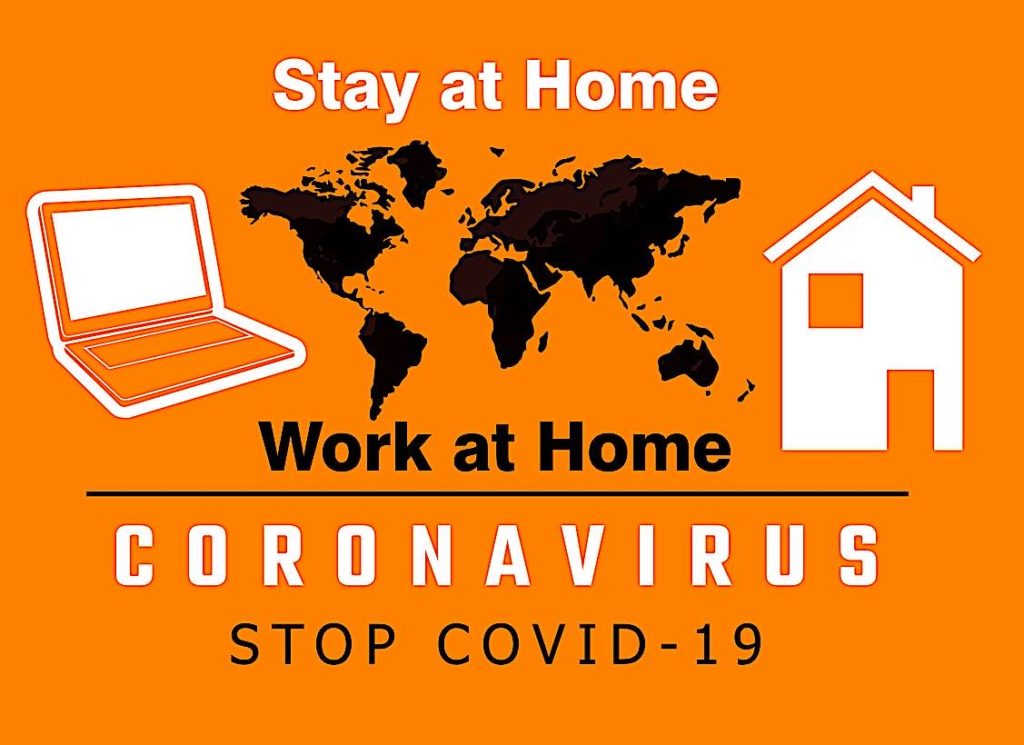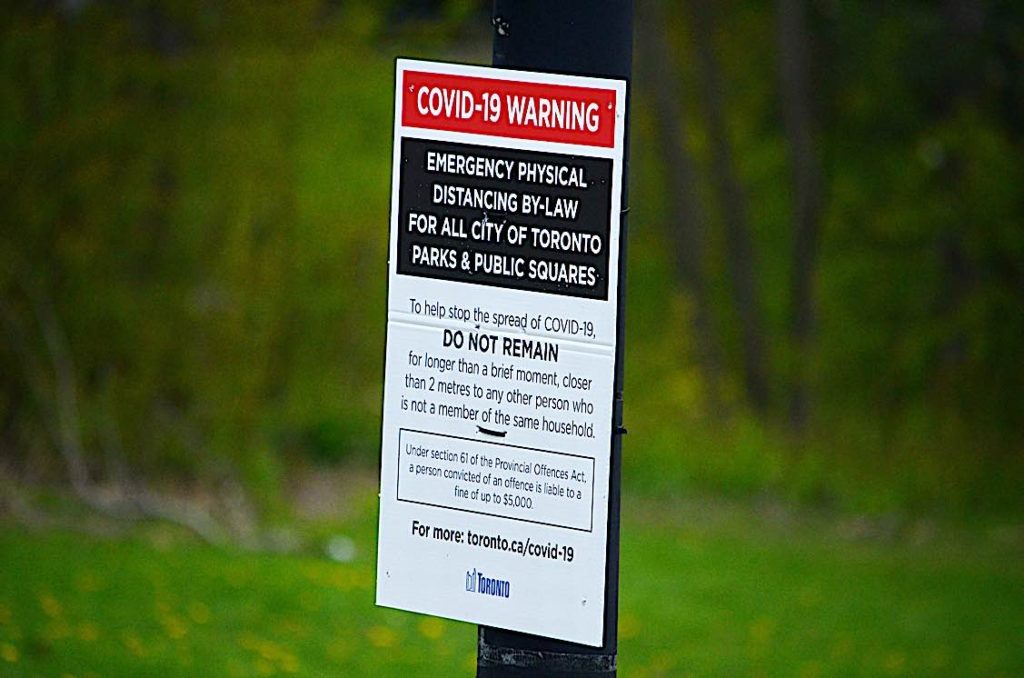
Province-Wide Shut Down & New Emergency Orders Per a Declaration of Emergency: Covid 19 HR Management
As a response to the distressingly high illness and mortality rates, since the start of the pandemic, there will be a province-wide shutdown and a second declaration of a state of emergency to significantly reduce the number of contacts people are having and thereby reducing the number of illnesses and deaths we are currently facing in Ontario due to COVID-19. [Extensive list of rules and recommendations below.]
Effective this Thursday, January 14, 2021, the government is issuing a stay-at-home order that requires everyone to remain home, except for “essential purposes,” such as grocery shopping or pharmacy visits, accessing health care services, for exercise, or for work, specifically if the work cannot be performed remotely. These stay-at-home orders are in effect for at least 28 days or at least until February 11th, 2021.

This order and other new and existing public health restrictions are intended to limit the mobility of individuals and limit outings to specific purposes only. In so doing, reducing the number of daily contact with those outside one’s immediate home.
All businesses must now ensure that any employee, who can work from home, does so with very limited exceptions, for example, if the nature of work necessitates that an employee be on-site to perform certain or all tasks.
Additionally, it has been announced that any business or organization that remains open during the province-wide state of emergency will be required to wear a mask or face covering that covers their mouth, nose, and chin, when they are indoors at all times.
It is also recommended to wear a mask or a face covering when outdoors, and physical distance of at least two metres cannot be maintained.
A declaration of emergency automatically terminates 14 days after being made unless terminated earlier or extended. To determine whether an extension or an early termination of the emergency, the province will observe key public health indicators.

During this time, these measures will be strictly enforced. All provincial offences officers, including Ontario Provincial Police, Local Police Officers, By-Law Officers, and provincial Workplace Inspectors or MOL inspectors will be authorized to remove crowds both indoors and outdoors (i.e., if crowds of more than 5 people not from the same household gather outdoors they will be required to leave and the location will be closed). Additionally, enforcement officials will have the authority to issue tickets to individuals and businesses if found not in compliance with any order set out by the province (i.e., staff or customer not wearing a face covering or a business not enforcing the new requirements).
These measures are identified as general public health and workplace safety measures that are applicable to all businesses, organizations, and facilities as well as individuals:
| Requirement | Description | General Measures to Consider: |
| Work from Home Except Where Necessary | · Those responsible for a business/organization that is open shall ensure that anyone who works for this business/organization conducts their work remotely, with limited exception, for instance, where the nature of their work requires them to be on-site at the workplace. | · All staff able to work from home must do so with exceptions such as compulsory collaboration, printing/scanning which cannot be done at home, trades jobs, access to files that are housed at work, etc. |
| Physical (Social) Distancing and line management | · There is a potential for exposure through crowding and/or close contact.
· The Chief Medical Officer, public health officials, and government communications have instructed that a business/organization must not permit patrons to line up inside the workplace/business to line up or to congregate outside of the business/workplace unless they are maintaining a physical distance of at least two metres from other groups of persons and wearing a mask or face covering that covers their mouth, nose, and chin unless they are entitled to an exception set out in the regulation. |
· Ensure signage inconspicuous areas for physical distancing.
· Limit contact among employees as much as possible by segregating the workplace and keeping employees within different work zones. · Desks and work areas will be rearranged for increased distancing, and/or plexiglass barriers will be installed for those at the workplace. · Staggering start/end time, breaks, and lunches to limit the number of people entering or exiting the workplace and these areas. · Controlling movement within the workplace (limiting the potential for workers to gather) by: – putting down arrows on the floor to guide employees. – Limits will be put on the number of people allowed in an area to maintain social distancing, once exceeded, no more people will be permitted to enter. – Designate specific doors for entering and exiting the workplace. – One-way staircases will be implemented when possible to reduce potential contact. – Eliminate punch clocks – using a web-based app to clock in and out – Employees are restricted to their work area only. – As much as possible the use of telephone or email or Microsoft Teams will be used for day to day interactions with each other · Meetings and offices: – No communal sharing of offices. – All meetings should be conducted virtually only using Zoom or Skype – Holding meetings in an outside or large space where people can be socially distanced. Note that no more than 5 people are allowed outdoors physical distancing, and face coverings are a must. – At times, task-specific activities may require workers to work in close proximity to each other, and physical distancing is not feasible. In this event, additional PPEs are mandatory, including latex gloves, masks, and eye coverage. Protection of the eyes, nose, and mouth is required if a worker is required to come within 2 metres of another person who is not wearing a face covering and not separated by plexiglass or some other impermeable barrier. Wash hands immediately after the task is complete. – At all reasonable opportunities, remove doors and door handles. Where doors and door handles cannot be removed, a means of protecting workers such as paper towels will be provided to limit skin contact. · It is recommended that workers, visitors, and support staff travel to the workplace in separate vehicles in order to maintain social distancing. If not, masks must be used to prevent the spread. Note no more than 2 people will be allowed in vehicles which are not of the same family. |
| Screening Upon Entry | · A businesses/ organization must operate in compliance with the advice, recommendations instructions issued by the Office of the Chief Medical Officer of Health on screening individuals. All workplaces must screen any workers or essential visitors entering the work environment or before each shift. See the COVID-19 Screening Tool for Workplaces for more information.
· The screening questions can be completed on paper, online, or by asking staff directly. |
· A screening questionnaire is provided at all entrances and can be completed by employees and visitors electronically on cell phones via an application. Paper-based forms are also available for those that require it.
· If someone is checking people in as they enter a building, it is recommended that they wear a face-shield and eye protection in addition to wearing a mask or face covering. · Individuals with chronic symptoms due to a medically diagnosed condition other than COVID-19 should look for new, different, or worsening symptoms. · Temperature checks, while not recommended as an effective means of discovering COVID-19 but might give employees a heightened sense of safety may be conducted as an added measure. |
| Maintain Logs of employees and visitors entering the office | · Public Health will require this information if there is a positive case for tracing | · Require updated contact information from employees
· This information will help with contact tracing if a case is discovered – keep electronic records via an application, spree sheet, or manually record. |
| Capacity Limits (if Open to the Public) | · All businesses/ facilities must limit capacity so that every member of the public is able to maintain two metres of physical distancing from every other person, and limit the number of people occupying any room that is open to the public to 50% capacity of the particular room. (Some businesses or facilities have additional capacity restrictions that apply beyond the general capacity requirements). | · All businesses or facilities that engage in retail sales to the public must post a sign in a location visible to the public that states the maximum capacity they are permitted to operate under.
· Please Note: |
| Cleaning & Disinfection of all areas | · There is a potential for exposure with highly used/touched surfaces.
· Businesses/ workplaces that are open shall ensure that equipment, washrooms, locker rooms, change rooms, showers are cleaned and disinfected as frequently as is necessary to maintain a sanitary condition. |
· The workplace will implement additional cleaning measures or utilize a third party service to clean/disinfect common areas and high-touch points, such as doorknobs, railings, eating surfaces, shared tools and equipment, washroom facilities, sign-in stations, lockers, change rooms, etc.
· Commonly-used vehicle’s surfaces will be thoroughly cleaned and disinfected at the end of each shift and between users. · For the use of equipment and other high touch areas (i.e., printer, scanners, coffee machines, water fountains, and microwaves): – Use latex gloves. They must be treated the same as bare hands in terms of minimizing unnecessary touching of anything on-site and the wearer’s face. Take care to not touch exterior of latex gloves when removing them, and wash your hands directly afterward. – Or cleaning products and disinfectants must be available and used after every use. · Individuals are responsible for cleaning their own workstations and should ensure surfaces are cleaned after every use and at least once daily. For ex, A 10 minute “clean break” will be done daily where every employee will clean/disinfect their own workspace (keyboards, monitors, phones, desks etc.) using disinfectant wipes that will be provided by their employer. Work schedules will accommodate necessary cleaning and disinfecting as required · At washrooms or shower facilities, hands-free taps, paper towel dispensers, and soap dispensers is recommended be installed wherever possible to accommodate social distancing. One person at a time in using the washroom or shower facility. The use of washrooms will be restricted to those that work in that particular area only. |
| Face Coverings | · Every person in the premises of a business or organization that is open shall ensure that they wear a mask or face covering that covers their mouth, nose, and chin, when they are in indoor areas of the premises, with limited exemptions | · Masks must now be worn at all times except for when eating and drinking.
· Ensure signage inconspicuous areas. Issue and post a Face Mask Policy and Procedure, which is effective for visitors and employees. · Training on meaning, how to, and the importance of wearing face masks is required. Documentation of who has been trained should be kept. · Masks are available to employees as needed at the entrance(s). |
| Safety Plans | · Requirement for all businesses open to prepare and make available a COVID-19 safety plan. A copy of the plan shall be made available to any person for review upon request and be posted where it would come to the attention of individuals working in or attending the business. | · Issue and post the Covid-19 Safety Plan in a conspicuous area for all to be notified of and review. |
| Hand & Respiratory Hygiene | · Employees should wash their hands often with soap and water for at least 20 seconds or, if not available, use alcohol-based hand sanitizer (with an alcohol content level of 70% or greater) as much as possible and when handling equipment, touching surfaces, and before/after eating. | · Ensure signage in conspicuous areas
· Ensure handwashing facilities are available with soap and water · Ensure Alcohol sanitizer with at least 70% or greater Alcohol content is available in highly used areas. · Employees should be cautious that they do not touch the mucous membranes of their eyes, nose, or mouth with hands. |
| Lunch & Break Periods | · Physical distancing may be difficult as these rooms are usually small | · Recommended closing lunch room (eat in the car or at desk or outside) during this time. |
| Paper Handling | · Potential for exposure with the distribution of papers | · Remove as much paper handling between workers as possible. |
| Deliverers and Visitors | · Deliverers and visitors could possibly expose employees or be exposed at the workplace. | Recommendations include:
· Delivery zones will be clearly marked and open to receivers and deliverers only. · When possible, nothing is passed between the deliverer and the receiver (ex: shipping documents or pens). · Deliveries are unloaded only by receivers, and deliverers are to remain in their vehicles. · Touch-screen devices used to accept deliveries must be disinfected prior to use. · No visitors be allowed at this time · If a visitor is approved to visit, they are limited to a meeting with no more than one Company employee in the large boardroom. Screening, social distancing and PPEs rules will apply and the visitor must wear a mask at all times, as well as sign and adhere to the company Face Mask Policy. |
| Air Purifying and Ventilation | · Cleaning air in the workplace to help reduce the risk of exposure. | Recommendations include:
· Ensure HVAC systems meet industry standards and are properly maintained. · Supply and use portable air cleaners. · Ventilate the office to have air exchange after regular business hours or during if possible by opening windows. |
| Waste Removal | · Potential exposure through hazardous waste | Recommendations include:
· Remove waste from the workplace each day. Ensure any potentially hazardous waste is properly treated. |
| Sneezing, Coughing or Using a Kleenex/Tissue | · Potential for exposure if not using proper etiquette when sneezing, coughing or using a tissue | · Employees should cough or sneeze into a tissue or the crook of your arm (not your hand);
· Employees should use a tissue, discard immediately and wash hands properly directly afterward. |
| Business Travel | · After Out of Country travel, a 14-day self-isolation is mandated by the federal government. | · Non-essential business travel is not authorized. Business travel is limited, on an exception-basis only.
· All individuals returning from out of the country must undergo a 14-day self-isolation period. |
The businesses that are permitted to be open and sector specific restrictions will be as follows:
| Supply Chain | · Businesses (permitted to be open within Ontario) that supply to other businesses/places.
· Or businesses that supply businesses or services that have been declared essential in a jurisdiction outside of Ontario, with the support, products, supplies, systems, or services, including processing, packaging, warehousing, distribution, delivery, and maintenance needed to stay open and operate.
|
| Meeting/Event Spaces | · Only permitted to open for:
o The operation of child care centres and authorized recreational and skill-building programs within the meaning of the Child Care and Early Years Act, 2014 o Court services o Government services o Mental health and addictions support services (e.g., Alcoholics Anonymous) permitted to a maximum of 10 people o Social services Note that contact information is required to be recorded in case of contact tracing. |
| Retailers | · Safety supply stores, businesses that sell/rent/repair assistive/mobility/medical devices, and optical stores that sell prescription eyewear to the public should be by appointment only and should limit the number of persons occupying any room that is open to the public in the business to not exceed 50% capacity of the particular room
· Curbside pick-up /delivery is permitted but operating hours can only be between the hours of 7am to 8pm. |
| Motor Vehicles Sales | · Including businesses selling cars, trucks, motorcycles, recreational vehicles including motor homes, trailers/travel trailers, boats/watercrafts/, power-assisted bicycles, golf carts, scooters, snowmobiles and all-terrain vehicles should now be by appointment only. Members of the public must not be permitted where products are either sold/displayed for sale. Subject to certain conditions related to test drives and operating hours can only be between the hours of 7am to 8pm |
| Manufacturing | · Businesses that extract, manufacture, process and distribute goods, products, equipment and materials, including businesses that manufacture inputs to other manufacturers (e.g. primary metal/ steel, blow molding, component manufacturers, chemicals, etc. that feed the end-product manufacturer), regardless of whether those other manufacturers are inside or outside of Ontario, together with businesses that support and facilitate the movement of goods within integrated North American and global supply chains are permitted to be open with safety measures in place |
| Services | · Rental/leasing services (including automobile, commercial and light industrial machinery and equipment rental) should be by appointment only.
· Vehicle and equipment repair and essential maintenance and vehicle and equipment rental services should be by appointment only. · Other service businesses/organizations permitted to be open with safety measures in place include: o Veterinary services (for services that are necessary for the immediate health and welfare of the animal only, or provided through curb side pick-up and drop-off of the animal) o Other businesses that provide for the health and welfare of animals, including farms, boarding kennels, stables, animal shelters and research facilities o Other services are included at this link on pages 19-21 |
| Maintenance | · Maintenance, repair and property management services that manage and maintain the safety, security, sanitation and operation of institutional/commercial/industrial/residential properties and buildings are permitted to be open with safety measures in place. |
| Financial Services | · Financial businesses/organizations permitted to be open with safety measures in place include:
o capital markets and related securities trading and advisory services o Banking/credit union activities including credit intermediation o Insurance o Land registration services o Pension and benefits payment services o Financial services including payroll and payment processing o Accounting and tax services |
| Research | · Research businesses/organizations that maintain research facilities and engage in research (including medical research and other research and development) activities are permitted to be open with safety measures in place |
| Health care and social services | · Health care and social services permitted to be open with safety measures in place include:
o Manufacturers, wholesalers, distributors and retailers of pharmaceutical products and medical supplies, including medications, medical isotopes, vaccines and antivirals, medical devices and medical supplies o Manufacturers, distributors and businesses that provide logistical support of or for products and/or services that support the delivery of health care in all locations o Organizations that provide critical personal support services in-home or residential services for individuals with physical disabilities o Organizations/providers that deliver home care services or personal support services to seniors and persons with disabilities o Regulated health professionals o Professionals or organizations that provide in-person counseling services o Organizations that provide health care including retirement homes, hospitals, clinics, long-term care facilities, independent health facilities and mental health and addictions counseling supports o Laboratories and specimen collection centres o Organizations that support the provision of food, shelter, safety or protection, and/or social services and other necessities of life to economically disadvantaged and other vulnerable individuals o Businesses that are primarily engaged in the provision of health and safety training with conditions |
| Resources and energy | · Businesses that provide and ensure the domestic and global continuity of supply of resources (including, resource exploration, mining, forestry, aggregates, petroleum, petroleum by-products and chemicals) are permitted to be open with safety measures in place
· Electricity generation, transmission, distribution and storage and natural gas distribution, transmission and storage are permitted to continue with safety measures in place
|
| Construction | · Construction services or projects/related services (including land surveying and demolition services) are permitted to continue with safety measures in place |
| Agriculture and food production | · Businesses producing food and beverages, and agricultural products (including plants, including by farming, harvesting, aquaculture, hunting and fishing) are permitted to continue with safety measures in place
· Businesses that process, manufacture or distribute food, beverages, crops, agricultural products, animal products and by-products are permitted to continue with safety measures in place · Businesses that support the food or agricultural products supply chains and the health and safety of food, animals and plants are permitted to continue with safety measures in place
|
| Other | · Other sectors/businesses that may remain open are included at this link on pages 19-28 |
We anticipate more details to come including further guidance from the government. We will be monitoring and updating you on these as they come forth. If you have any questions or concerns about the province’s new directives, don’t hesitate to contact your HR Rep for assistance.



 Our HR solutions experts can recommend the right mix of HR outsourced services to make your entry into Canada easier.
Our HR solutions experts can recommend the right mix of HR outsourced services to make your entry into Canada easier.  Pivotal Employment Management Services co-hires your workforce, simplifying entry of your business in Canada.
Pivotal Employment Management Services co-hires your workforce, simplifying entry of your business in Canada. 















This Social Media Thing